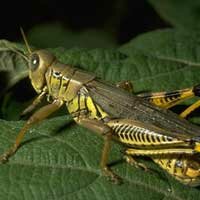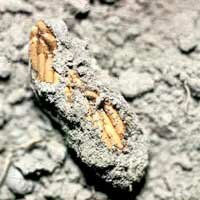
-
Soybean Diseases
- Asian Rust
- Anthracnose
- Bacterial Blight
- Bacterial Pustule
- Bean Pod Mottle Virus
- Brown Stem Rot
- Cercospora Leaf Blight
- Charcoal Rot
- Downy Mildew
- Frogeye Leaf Spot
- Green Stem Syndrome
- Iron Deficiency Chlorosis
- Phytophthora Root & Stem Rot
- Powdery Mildew
- Rhizoctonia
- Seedling Diseases
- Septoria (Brown Spot)
- SCN (Soybean Cyst Nematode)
- Soybean Mosaic Virus
- Stem Canker
- Sudden Death Syndrome
- Viruses
- White Mold
- Soybean Pests
- Diagnostic Help
- Field Trials
- Soybean Library
| Pest: Grasshoppers |
Your Soybean Checkoff.
Delivering Results.
Illinois
Indiana
Iowa
Kansas
Michigan
Minnesota
Missouri
Nebraska
North Dakota
Ohio
South Dakota
Wisconsin
Grasshopper Pests of Soybean
 |
| The differential grasshopper is one of five species most common in agricultural land. Photo credit: B. Drees, Texas A&M University |
 |
|
Grasshopper egg pod
Photo credit: University of Illinois |
Grasshoppers are relatively large insects, capable of doing considerable damage in a short amount of time. In early summer, grasshoppers normally feed on grasses and weeds in non-crop areas, and move into fields later in the season. In general, damage to crops is most severe in dry years.
Corn, soybeans, small grains and other crops may have localized problems with this pest when grasshopper populations are high. Grasshopper nymphs can consume entire soybean seedlings. On more mature plants, the nymphs eat irregular holes in the leaf issue. Adult grasshoppers consume entire leaves, except the tougher veins, and also feed on the pods.
Grasshopper populations are strongly influenced by climate
Outbreaks of this pest are more likely after two or more years of dry weather. Long, warm autumns, followed by warm, dry springs contribute to the building of grasshopper populations. A long, warm autumn favors egg-laying by grasshoppers.
The most widely distributed and economically important grasshopper species in the North Central region are
- Differential grasshopper, Melanoplus differentialis. This grasshopper favors cultivated land and can be a severe pest of small grains, corn, alfalfa, soybeans, some vegetables, and fruit trees.
- Twostriped grasshopper, Melanoplus bivittatus. This species feeds on a mixed diet of many kinds of plants and can be a major pest on small grains, alfalfa, and corn.
- Migratory grasshopper, Melanoplus sanguinipes. This species has a very broad distribution and causes more damage to field crops, gardens, and rangeland than any other species of grasshopper in North America. Small grains are particularly vulnerable. Migratory grasshoppers feed on foliage, fruit, and bark.
- Red-Legged grasshopper, Melanoplus femurrubrum can be a crop pest in alfalfa, clover, soybeans, corn, and small grains. Large numbers can develop in pastures.
- The clearwinged grasshopper, Camnula pellucida, prefers grasses and small grains.
